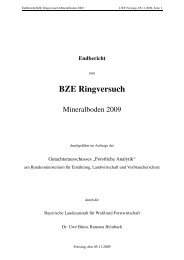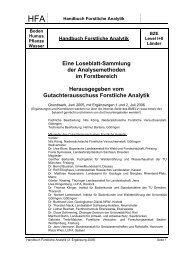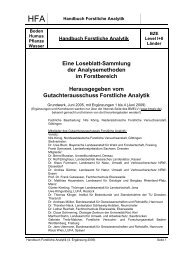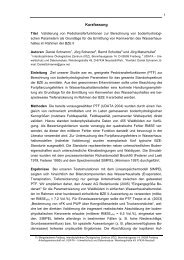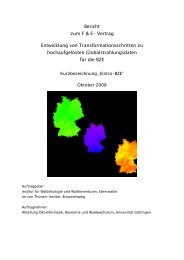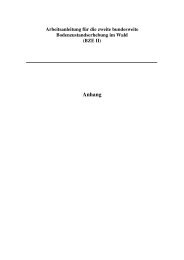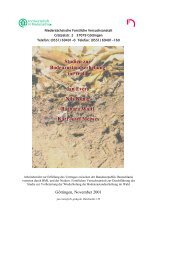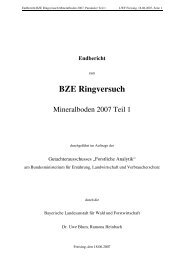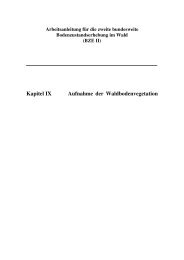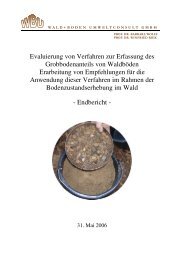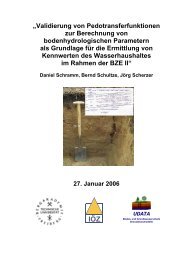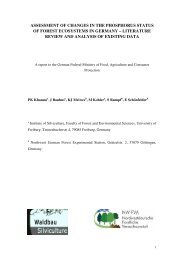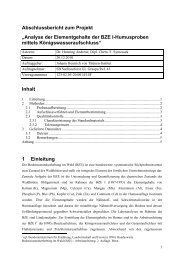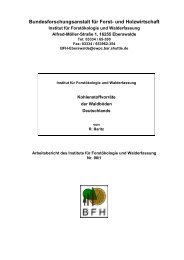assessment of changes in the phosphorus status of forest ...
assessment of changes in the phosphorus status of forest ...
assessment of changes in the phosphorus status of forest ...
You also want an ePaper? Increase the reach of your titles
YUMPU automatically turns print PDFs into web optimized ePapers that Google loves.
sequential extraction scheme <strong>of</strong> extract<strong>in</strong>g <strong>in</strong>organic fractions, assign a degree <strong>of</strong><br />
lability to each <strong>of</strong> <strong>the</strong> organic fraction (Tiessen and Moir 1993). Table 8 shows one<br />
such sequential fractionation method for agricultural soils, which has also been widely<br />
used for research purposes for <strong>forest</strong> soils. We shall discuss <strong>the</strong> use <strong>of</strong> <strong>the</strong>se methods<br />
for assess<strong>in</strong>g <strong>changes</strong> <strong>in</strong> <strong>the</strong> <strong>forest</strong> soils <strong>of</strong> Germany.<br />
Sequential extraction methods are highly resource consum<strong>in</strong>g. As can be seen <strong>in</strong><br />
Table 8, 7 different extractions and analyses are required to quantify <strong>the</strong> different P<br />
fractions. Therefore <strong>the</strong>se methods are commonly reserved for research purposes, but<br />
are probably not suitable for rout<strong>in</strong>e monitor<strong>in</strong>g purposes, where large numbers <strong>of</strong><br />
samples are <strong>in</strong>volved (e.g., BZE). However, <strong>the</strong>re are potentially two alternatives<br />
available:<br />
(a) to develop pedo-transfer functions suitable for calculat<strong>in</strong>g <strong>the</strong>se different fractions<br />
<strong>in</strong> soils from soil parameters that are simple to analyse (e.g. Total P or C <strong>in</strong> <strong>the</strong><br />
soil) (Ulrich and Khanna 1968, Ulrich 1972), and<br />
(b) to develop a purpose-based analytical method such as to determ<strong>in</strong>e available P,<br />
where specific chemical extraction procedures are employed. A typical example<br />
<strong>of</strong> this approach is <strong>the</strong> wide use methods for quantify<strong>in</strong>g available soil P <strong>in</strong><br />
agriculture. These soil test<strong>in</strong>g methods are specifically designed for<br />
recommend<strong>in</strong>g suitable doses <strong>of</strong> fertilizer <strong>in</strong>puts to crops. The most commonly<br />
used methods are outl<strong>in</strong>ed <strong>in</strong> Table 9. These methods <strong>in</strong>clude simple extraction<br />
with water (water extracts from soils which have accumulated high amounts <strong>of</strong> P<br />
through fertilizer <strong>in</strong>puts <strong>in</strong> easily dissolved forms), mild exchange <strong>of</strong> P present on<br />
solid surfaces (anion res<strong>in</strong> methods), mild extractants us<strong>in</strong>g anions (lactate<br />
methods Egner and Riehm, bicarbonate method by Olsen et al; fluoride methods –<br />
Bray; acid methods – Mehlich; and many o<strong>the</strong>rs), methods described by Kuo<br />
(1996). To predict fertilizer demand <strong>of</strong> annual crops <strong>in</strong> agricultural soils, <strong>the</strong><br />
amount <strong>of</strong> P obta<strong>in</strong>ed by chemical extractants is related to plant P uptake, which is<br />
measured through biomass growth and P concentration <strong>in</strong> plant tissue. Through<br />
suitable regression and o<strong>the</strong>r statistical methods, critical soil test values are <strong>the</strong>n<br />
derived. Evidently, <strong>the</strong> purpose and usefulness <strong>of</strong> such methods for <strong>forest</strong> soils are<br />
highly questionable. Firstly, <strong>the</strong> annual P uptake is extremely difficult, if not<br />
impossible to quantify, s<strong>in</strong>ce new tree tissue can also be built with P that has been<br />
stored with<strong>in</strong> <strong>the</strong> tree or mycorrhiza, or has been retranslocated from age<strong>in</strong>g or<br />
senesc<strong>in</strong>g tissues. Thus <strong>the</strong> system is much more buffered aga<strong>in</strong>st short-term<br />
fluctuations <strong>in</strong> P supply from soil. Secondly, ow<strong>in</strong>g to <strong>the</strong> fact that P is commonly<br />
51



